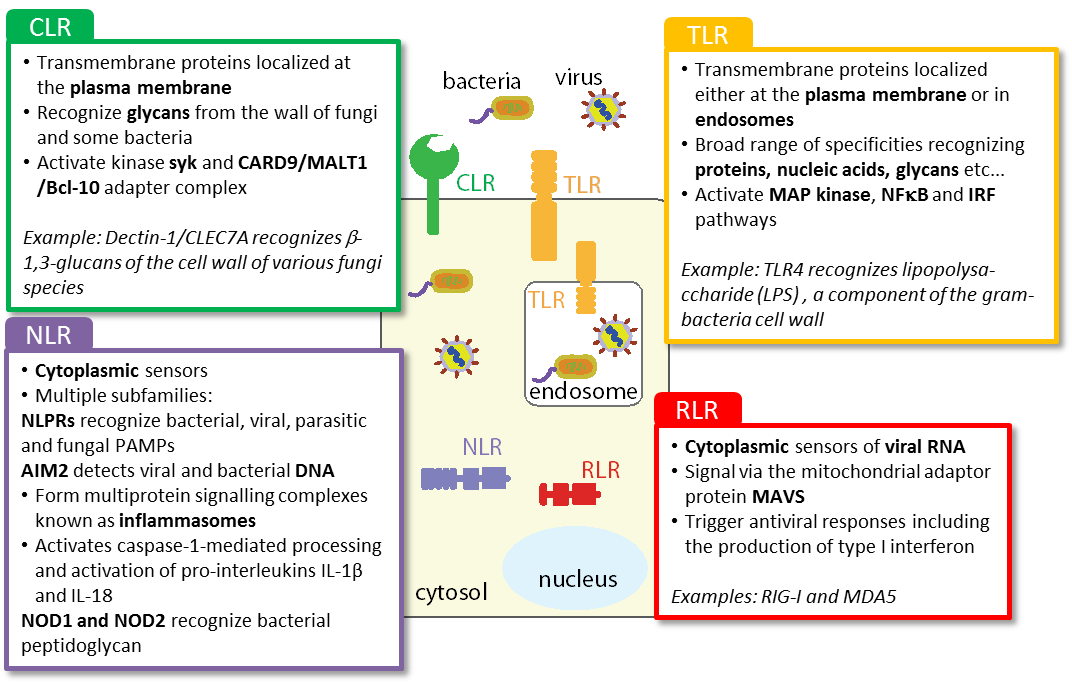BiteSized Immunology: Receptors & Molecules

Pattern recognition receptor (PRRs) ligands
Upon a microbial infection, the body needs to be alerted to the presence of potential harmful pathogens. This is achieved through specialised receptors known as pattern recognition receptors (PPRs) which are predominantly expressed on immune cells.
These receptors recognize conserved molecular structures known as pathogen- or damage-associated molecular patterns (PAMPs and DAMPs) that are found in microbes such as bacteria, viruses, parasites or fungi. These motifs are usually specific to the micro-organism (i.e. they are not present in the host and therefore are considered as “non-self”). They are also essential for its viability and thus less subjected to changes which would make otherwise their recognition by the host more difficult.
One of the best characterized PAMP is lipopolysaccharide (LPS), a specific component of the gram – bacteria which is recognized by Toll-like receptor TLR4.
Below are some examples of PAMPs (Figure 1):
Glycans
- Lipoglycans such as lipopolysaccharide, a component of the gram- bacteria outer membrane
- Peptidoglycans such as bacterial muramyl dipeptide
- b-1,3-glucans from the cell wall of various fungi species
Proteins
- bacteria flagellin
Nucleic acids (RNA or DNA)
Microbial nucleic acids usually have features that are recognized as non-self by the host.
- Location: microbial nucleic acids may be found in specific location such as endosomes where normally the host nucleic acids are not present. For instance, TLR7 recognize viral RNA in the endosomes.
- Properties: microbial nucleic acids have often specific structure, length or modification such as bacterial DNA which contains unmethylated repeats of dinucleotide CpG or viral double-stranded (ds) or single-stranded (ss) RNA.

In order to detect pathogens such as bacteria and viruses the immune system is equipped with receptors called pattern recognition receptors (PRRs) that are specialised in their recognition. These receptors are a key element of the innate immune system. They are mainly expressed by antigen presenting cells such as dendritic cells and macrophages, but they are also found in other immune and non-immune cells.
The PRRs are divided into four families:
- Toll-like receptors (TLR)
- Nucleotide-binding oligomerization domain-like receptors (NLR)
- C-type lectin receptors (CLR)
- RIG-1 like receptors (RLR)
These receptors are strategically localised in the cell. There are present at the cell surface to recognise extracellular pathogens such as bacteria or fungi, in the endosomes where they sense intracellular invaders such as viruses and finally in the cytoplasm.
These receptors recognise conserved molecular structures of pathogens. These motifs called pathogen- or microbe-associated molecular patterns (PAMPs or MAMPs) are usually specific to the microorganism and essential for its viability. PAMPs that have been identified so far are proteins (e.g. bacterial flagellin), nucleic acids (e.g. viral ssRNA) or glycans (e.g. bacterial lipopolysaccharide (LPS)).
The four PRR families usually differ in their ligand recognition, signal transduction and sub-cellular localisation (Figure). Upon activation, they induce various cellular responses including the transcription of several genes that ultimately will result in the elimination of the pathogen. They also often cooperate with each other to ensure that the response is optimum. Besides their role in innate immunity, some of these receptors (e.g. NLR) are also involved in sensing “danger” signals resulting from perturbations of normal cellular processes.

© The copyright for this work resides with the BSI.
